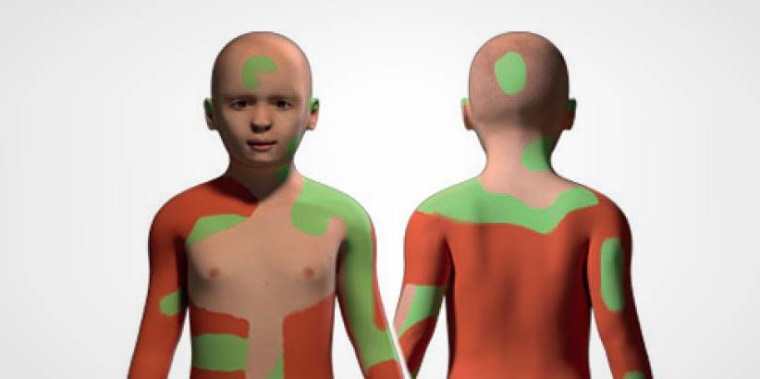Seven-year-old Hassan was dying. An infection had destroyed most of his skin, he was too weak to eat, and he was in agony.
Doctors in Germany were planning to provide palliative care — keeping Hassan as comfortable as possible while he died. But there was another option: an experimental skin graft.
It worked. The graft replaced 80 percent of Hassan’s skin, and he’s back at school, leading a normal life, the researchers reported Wednesday in the journal Nature.
"The amount of coverage that (the team) was able to achieve on this patient and the impact that this has had on the patient's life is really incredible," said Dr. Peter Marinkovich of Stanford University, who also uses skin grafts to treat similar patients.
"It shows the promise of what we are doing."
Hassan, identified only by his first name, has a rare genetic condition called junctional epidermolysis bullosa. This particular type of epidermolysis bullosa (EB) is caused by defects in genes that control development of a membrane in the epidermis — the top layer of skin.
Kids with EB, sometimes called “butterfly children” because their skin is as fragile as butterfly wings, develop painful blisters when their skin layers rub against one another with any movement. They are vulnerable to infections and skin cancer and often die before age 30. There is no cure.
“Since birth, the patient had developed blisters all over his body, particularly on his limbs, back and flanks,” the researchers wrote. His blistered skin had been attacked by two bacterial infections that destroyed most of it.
Related: Helping 'butterfly children'
Skin grafts usually don’t work for these patients because of the genetic mutations controlling how the skin grows. The boy had been given skin grafts from his father, but they did not last.
However, some earlier experiments had shown it might be possible to take some skin from a patient, replace the faulty gene using gene therapy, grow the skin into sheets in the lab, and then graft it back.
But this approach had only been tried on two children and only replacing small patches of skin. And the treatment itself could kill Hassan.
The desperate parents asked to try it, anyway.
“His epidermis is currently stable and robust, and does not blister, itch, or require ointment or medications."
The team at Children’s Hospital at Ruhr University in Bochum, Germany teamed up with specialists across Europe, led by Dr. Michele De Luca of the University of Modena and Reggio Emilia in Italy, a specialist in regenerative medicine.
They took a patch of non-blistered skin from the boy’s leg and used a virus to carry a corrected version of the bad DNA into his skin cells.
They grew grafts of the corrected skin and, in three separate operations over several months, replaced the missing skin.
Related: Regenerative Medicine Grows New Organs in the Lab
Hassan was in terrible shape. He’d lost much of his body weight and was kept sedated at first because of the agonizing treatment.
But the grafts took, and grew, the team reported.
“He was discharged from the hospital in February , 2016,” De Luca told reporters in a telephone briefing.
“His epidermis is currently stable and robust, and does not blister, itch, or require ointment or medications,” the team wrote. “The child returned to regular elementary school in March 2016.”
Tests showed that the gene therapy corrected immature cells known as stem cells. These stem cells replenished the skin cells with normal, healthy skin.
“The paper was able to show that in fact it is a specific cell population that gives rise to the continued regeneration,” said Dr. Anthony Atala, a specialist in regenerative medicine at Wake Forest University who was not involved in the research.
It’s one of several approaches being tried to help children and adults with EB. About 20 in every 1 million babies born in the U.S. have one of the various forms of the condition and advocacy groups estimate between 25,000 and 50,000 people in the U.S., mostly children, currently have EB.
Related: 9-Year old Raises Money for Friend With 'Butterfly' Disease
Last year Marinkovich's team at Stanford used gene therapy to treat four adults with a form of EB that is a little different from the case of the boy in Germany. But they only replaced patches of skin the size of playing cards, Marinkovich said.
They are now recruiting patients for a bigger experiment to prove it's safe to do in children.
"This is really the way to go. You can get to the patients early before they have all the complications and suffering," Marinkovich said.
